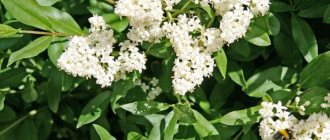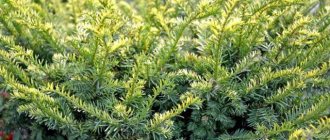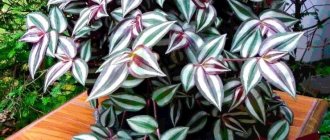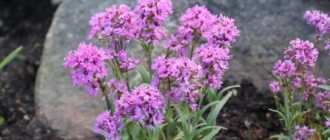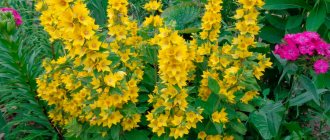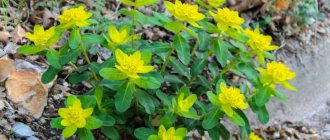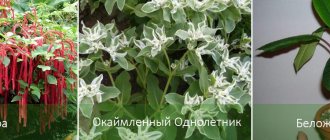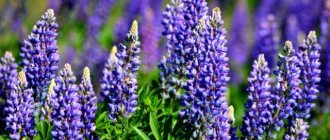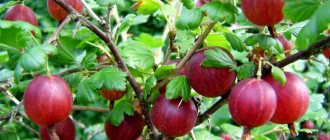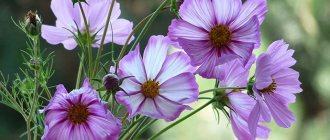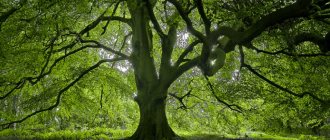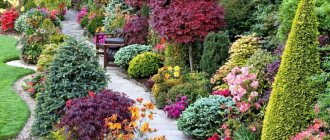Creating a flower bed
Before planting plants, you need to carefully prepare the flowerbed and create conditions for flowers in the shade.
Selecting a location
Decide where the flowers will grow - near a private house or in the garden. It is better to give preference to an area that will receive enough sunlight for the plants, but will also have shade. This way you can mix varieties of beautiful flowers and plants.
Remove perennial weeds from the area; herbaceous species can be destroyed with drugs, and the roots of perennial plants can be removed mechanically.
If you want to plant a variety of flowers in your garden, consider their size. Low perennial beautiful flowers can be used as an edging to design a flower bed; tall annual and perennial flowers are best planted in the middle in the shade so that they do not interfere with low annual herbaceous flowers and plants with small foliage.
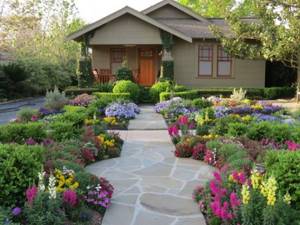
Determining soil type
For perennial and annual flowers, it is important to choose the soil before planting the plants. The soil for flowers in summer should be crumbly.
If the soil is too clayey, add sand to it. It is better to mix infertile soil with compost during the maintenance process. Also, don't forget to fertilize your beautiful perennials and annuals before planting your flowers in the spring or summer.
Soil preparation and planting
To create a beautiful flower garden design at a private home, the place where the flowers will grow needs to be prepared:
- mark the flower bed;
- remove the layer of soil and fill in the drainage;
- fill in the soil, which needs to be mixed with compost and fertilizers.
The soil for flowers in the shade or in a sunny place in the garden should be loose and fertile, while for bushes in the shade you can use simpler soil.
All that remains is to create levels and relief if desired and plant ornamental plants in the yard. In spring or summer, you should first plant large perennial flowers in the shade, moving on to annual flowers. After planting plants in the yard, you need to water the flowers more often, especially herbaceous perennials that reproduce by self-seeding.
The best types of herbaceous plants
At a time of extraordinary diversity of these flora representatives, choosing the appropriate species seems to be a difficult task. Below are the top ten perennial herbaceous plants that bloom profusely over a long period, and are also relatively undemanding to external conditions and the most resistant to diseases and pests. They will respond to a small amount of complex mineral fertilizer with lush flowering and rapid growth.
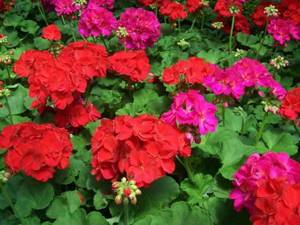
- Geranium Rozanne. This hybrid features large blue flowers and massive soft foliage. This is the only type of geranium that blooms throughout the summer. Such specimens reach fifty centimeters in height. With regular watering, it blooms very well and grows in the sunny side, but on dry soil it is necessary to provide it with partial shade.
- Pulavka. This, at first glance, an ordinary plant, is actually not so simple. Such a delicate creature constantly pleases with an abundance of yellowish inflorescences, which continuously replace each other all summer. Pulavka is officially recognized as one of the longest-flowering perennial herbaceous plants. Conditions for keeping: sunlight and not too wet soil. The maximum height of an adult plant is sixty centimeters.
- Catnip Fasen. This hybrid is of garden origin. With its advent, other varieties became unnecessary. Gray leaves appear in early spring, and beautiful purple-blue inflorescences delight the eye from May until the first frost. Very suitable for places with hot and dry climate, the only condition is to prevent getting wet. Grows up to sixty centimeters in height.
- Echinacea. Today this species is very common. Fatal Attraction is one of the best representatives of its family. Abundant flowering pleases the eye with pink buds on black stalks. Feels great in the sun in soil of average fertility. The size of an adult plant reaches eighty centimeters.
- Astrantia. Being long-lived, this variety is not too demanding on environmental conditions. The duration of flowering is not inferior to annuals. It is advisable to plant in a shaded place, carefully monitoring soil moisture. Grows up to one hundred centimeters.
- Oak sage. One of the most undemanding plants, which has many varieties, differing in shades, height and shape. The most common are the classic Mainacht, Viola Klose, Caradonna. If you cut off faded inflorescences in early summer, you can achieve re-blooming. Optimal conditions for growing are sunny side and moderately fertile soil. The combination of large tracts of oak sage looks very impressive and makes an unforgettable impression.
- Veronicastrum virginiana. A humble native of the prairies, this flower has recently become a favorite among gardeners. Looks great in the landscape of naturalistic styles, bending the outlines of ornamental grasses with its vertical line. Such demand provoked the emergence of dozens of new varieties, but Diane remained a classic. Grow in fertile soil on the sunny side. Adult specimens reach one hundred and twenty centimeters in height.
- Burnet Sanguisorba. This variety is universal because it develops well and grows in any light. It will feel good both in the sun and in the shade. This plant will fit perfectly into a naturalistic style flower garden. Thanks to its shiny green leaves, the burnet looks elegant and noble. Due to its undemanding conditions for growing, this plant is popular among gardeners. An adult plant grows up to one meter in height.
- Coreopsis whorled. Because this scraggly bush, surrounded by a cloud of yellowish flowers, looks unphotogenic in pictures and photographs, it rarely attracts attention. However, being in a common garden flower garden, coreopsis attracts the eye with its bright color and contrast, leaving no one indifferent. It is best to plant the flower in moderately fertile soil, where it will receive abundant sunlight. Under such conditions, coreopsis grows up to forty centimeters in height.
- Reed grass is short-haired. When choosing between valuable and unpretentious ornamental grasses, choosing a specific type is quite difficult. Closer to autumn, many cereal plants rise in the fields, competing with each other in beauty. Short-haired reed grass seems to have been specially created for this time of year. Covered with small dewdrops in the early foggy morning, this plant stands out effectively among others. The neat and decorative appearance creates extreme photogenicity and decorativeness. Short-haired reed grass grows well on the sunny side in moderately fertile soil, but will also feel good in partial shade. The maximum height of an adult plant can reach one hundred and twenty centimeters.
Thus, herbaceous plants are a life form that has stems and leaves, which die off on the soil surface at the end of the growing season. Their distinctive feature is the absence of a tree trunk above the ground. Herbaceous plants are classified according to their lifespan into annuals, biennials and perennials, and according to their appearance and growing conditions - into ornamental, agricultural, climbing and aquatic.
Flower garden design
Flower beds in the courtyard of a private house need to be arranged correctly. It's best to plan which plants you will plant in the shade. Preference should be given to unpretentious flowers that adapt to conditions in the shade. Lawn perennial grasses that reproduce in a flowerbed by self-sowing even in the shade are also welcome.
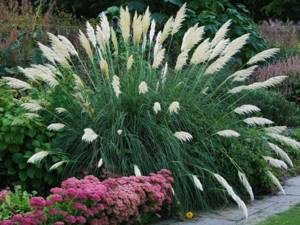
For perennial beautiful flower designs, it is better to choose low-growing plants in the yard. They are varied - these are pansies, salvias, and annual marigolds. The colors in the flowerbed in summer can also be varied. And such a beautiful decorative flower as pansy, combining several shades, will dilute a flowerbed in the shade with one variety.
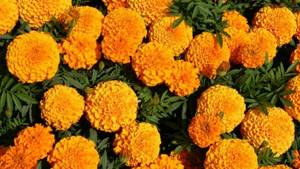
Annual marigolds
As for various borders and flower pots, it is recommended to mix plants such as begonias and alyssiums in them. Such perennial flowers can grow not only in the shade on a plot near a private house, but the flowers also look good in a sunny place indoors.
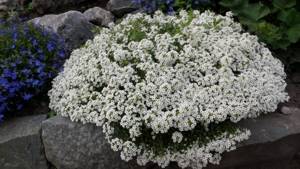
Alyssiums
If you want to decorate a bright flower garden with plants in your dacha of different shades of foliage, plant beautiful cineraria, ageratum and coleus in places in the shade. Flowers with such names have very interesting foliage.
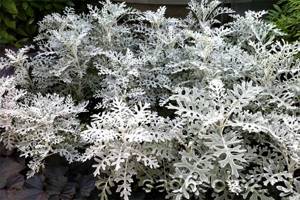
Cineraria
As a variety of separately planted flowers in a flowerbed in the courtyard of a private house, you can use beautiful lilies of the valley, violets, and low-growing roses. Lilies of the valley and violets, even in the shade of a flowerbed, will emit a pleasant aroma in the area when they bloom, if you water the flowers in time.
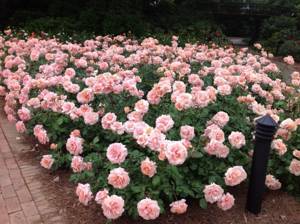
Low growing roses
Herbaceous crops: description, varieties
Herbaceous plants have a soft above-ground stem and tolerate cold throughout the year or several years in a row. The structure is different:
- roots;
- flower part;
- foliage.
Among the vegetation there are both dwarf and giant species: duckweed - from 4 to 15 mm and bamboo, reaching 35 m.
Depending on their lifespan, types of herbs are divided into:
- annuals;
- biennials;
- perennials.
Annual crops grow, bloom, ripen and die during one growing season. Reproduction method is by seed. include :
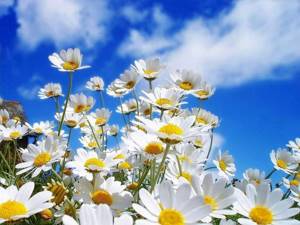
Chamomile
- chamomile;
- dill;
- peas.
In biennial plants, flowering does not occur in the first year of development. The roots, leaves and stem are improved. This class includes:
- pansies;
- mallow;
- bell.
The lifespan of perennial crops is more than 2 years. Perennials are endowed with a root system with renewal buds in the form of a tuber, bulb or shoots. They are divided into early and ultra-early, middle and late. These include:
- peonies;
- daffodils;
- delphinium.
Herbaceous annuals are planted in the soil in the spring by seedlings or seeds. Warm-season grasses are planted when the threat of spring frost has passed.
Most annual grasses can be replanted with the arrival of the summer season and at the budding stage.
Perennials are propagated by divisions into a permanent bed in spring or early autumn. A crop that blooms in the spring season requires replanting in the fall. Replanting grass is accompanied by a period of rest and adaptation and requires special care. For annual grasses, the period is 7-14 days, for perennial crops - 1 or 2 growing seasons.
Trees and conifers
It is not necessary to plant only bright flowers in your flower beds. Beautiful trees and shrubs that protect from dust look good near a private house in the shade and in the garden.
An interesting solution for a large plot of land in the shade would be to plant a pine tree. It is better to choose dwarf pines - they will grow even in the shade, but the roots of such trees will not damage the paths. Juniper is also popular - an evergreen plant that perfectly cleans the air. If you plant juniper under windows in the shade, it will protect the house from dust.
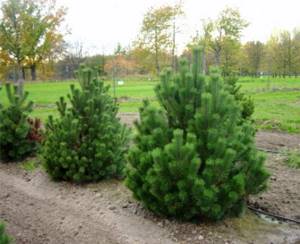
Decorative pine
Many gardeners recommend planting birch and viburnum in the shade near a private house. These trees have good energy, they grow large, especially the roots of the birch and the branches of the viburnum.
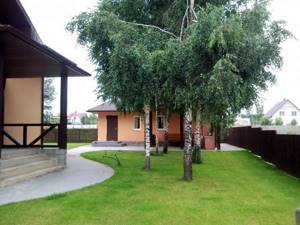
Birch
As a shrub that can also bloom, many people prefer to plant lilac near the house. Although lilac blooms only in spring, it blooms magnificently and for a long time. At the same time, in summer the plant will delight you with dark green leaves in front of the house. And caring for unpretentious lilacs in the shade is not difficult.
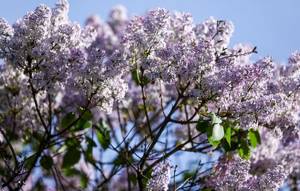
Lilac
Rose hips will exude a pleasant aroma, and you can use its fruits to make tea.
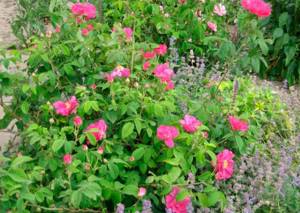
Rose hip
Many people decorate the flower beds in front of the house with roses, which first grow into bushes and then produce branches that can be clinging to something. The combination of blooming decorative rose buds with juniper trees in the flower beds in the courtyard of a private house looks unusual.
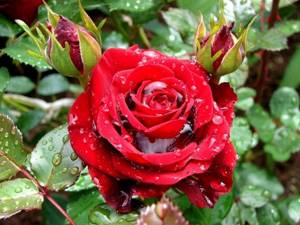
Roses
If you decide to plant a variety of plants in the flowerbed in front of the house, as well as shrubs in the shade, then it is advisable that the decorative background in the landscape design be unpretentious grass, which is easy to plant or sow. Sprinkle the soil in the flowerbed with compost in advance and water it. Such grass, even in the shade, will not only give a decorative look to a flower bed with a variety of flowers, but will also improve the soil and make it easier to care for shrubs.
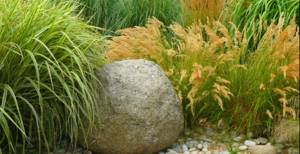
Several ornamental grasses
To ensure that the plants in your yard grow without creating problems with care, think over the design and also decide on the varieties. You need to take into account the care requirements for certain flower names before planting anything near your home.
What do herbaceous plants look like?
The most common sign of this life form is the fact that they do not have a perennial ground part that can survive an unfavorable time of year or season. However, this criterion applies only to those plants that live in a variable-seasonal climate: “summer-winter”. A perennial herbaceous plant growing in the southern tropics or deserts, it grows to a very impressive size. Such growth is achieved precisely due to the presence of a perennial above-ground part.
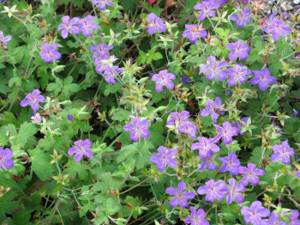
In this regard, in order to distinguish herbaceousness, biologists use another criterion - the fact of the absence of lignification of the ground part, which should be juicy, fleshy, incapable of secondary thickening, and also highly diluted with soft tissues. But even these signs do not always work. The fact is that trees, shrubs, and herbaceous plants are separated from each other by many intermediate forms. In addition, lignification to varying degrees is characteristic of many types of grasses.
The structure of a herbaceous plant includes the root system and shoot. The shoot is formed by leaves, stem and flower part.
Let's look at the main types of herbaceous plants.
Applications
Since time immemorial, people have eaten herbaceous plants. Naturally, their use depends directly on their characteristics.
- Spices. These include: rosemary, thyme, basil, dill, parsley, cumin, mint. They are used not only in making seasonings, but also to improve the taste of food.
- Medicinal herbs. These include: mint, calendula, sage, chamomile, calendula, plantain. These herbs are used both in folk medicine and in the production of pharmaceuticals.
- Decorative (climbing, flowering) plants are used to decorate garden plots and parks.
- Fodder - great as pet food.
